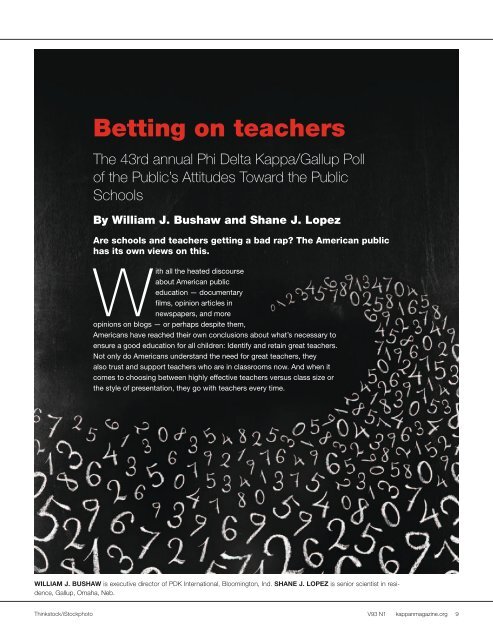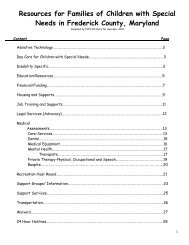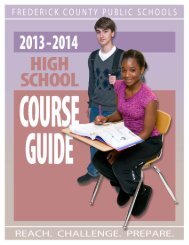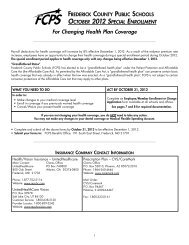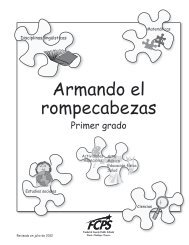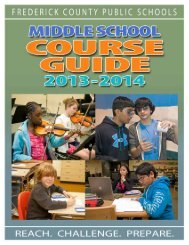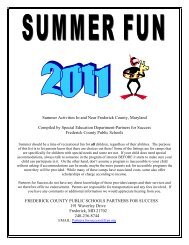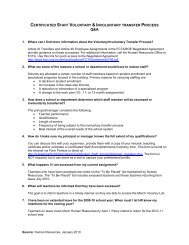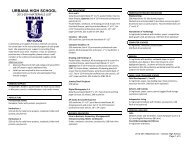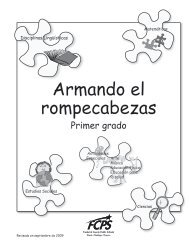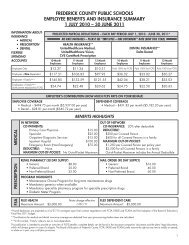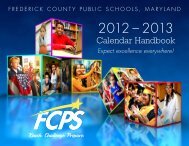43rd annual Phi Delta Kappa/Gallup Poll
43rd annual Phi Delta Kappa/Gallup Poll
43rd annual Phi Delta Kappa/Gallup Poll
You also want an ePaper? Increase the reach of your titles
YUMPU automatically turns print PDFs into web optimized ePapers that Google loves.
Thinkstock/iStockphoto<br />
Betting on teachers<br />
The <strong>43rd</strong> <strong>annual</strong> <strong>Phi</strong> <strong>Delta</strong> <strong>Kappa</strong>/<strong>Gallup</strong> <strong>Poll</strong><br />
of the Public’s Attitudes Toward the Public<br />
Schools<br />
By William J. Bushaw and Shane J. Lopez<br />
Are schools and teachers getting a bad rap? The American public<br />
has its own views on this.<br />
With all the heated discourse<br />
about American public<br />
education — documentary<br />
films, opinion articles in<br />
newspapers, and more<br />
opinions on blogs — or perhaps despite them,<br />
Americans have reached their own conclusions about what’s necessary to<br />
ensure a good education for all children: Identify and retain great teachers.<br />
Not only do Americans understand the need for great teachers, they<br />
also trust and support teachers who are in classrooms now. And when it<br />
comes to choosing between highly effective teachers versus class size or<br />
the style of presentation, they go with teachers every time.<br />
WILLIAM J. BUSHAW is executive director of PDK International, Bloomington, Ind. SHANE J. LOPEZ is senior scientist in residence,<br />
<strong>Gallup</strong>, Omaha, Neb.<br />
V93 N1 kappanmagazine.org 9
Should high-<br />
achieving<br />
students<br />
become<br />
teachers?<br />
Yes<br />
Percentages<br />
may not add up<br />
to 100% due to<br />
rounding.<br />
This is only part of the story emerging from the <strong>43rd</strong><br />
<strong>annual</strong> PDK/<strong>Gallup</strong> <strong>Poll</strong> of the Public’s Attitudes Toward<br />
their Public Schools. We asked Americans difficult, often<br />
controversial, questions about vouchers, charter<br />
schools, digital learning, teacher unions, and preparing<br />
students for careers and college. We discovered some<br />
surprising as well as predictable results.<br />
The <strong>annual</strong> PDK/<strong>Gallup</strong> poll is a scientifically based<br />
survey of about 1,000 Americans 18 years and older.<br />
The poll is unique and significant because its longitudinal<br />
data documents important changes in American<br />
opinion over time. Although the PDK/<strong>Gallup</strong> poll revisits<br />
many questions asked in previous polls, we also turn to<br />
a panel of advisors each year to help us identify emerging<br />
issues. Among this year’s issues are teacher recruitment,<br />
collective bargaining, digital learning and technology,<br />
education quality, school choice, schools as<br />
well-being centers, and a rating of President Obama’s<br />
support for public education.<br />
As in the past, every question asked is reported in<br />
this article, and all questions are listed verbatim as they<br />
were asked of the American public during a telephone<br />
poll in June 2011. And while we present our interpretations<br />
of the findings, we encourage readers to decide<br />
for themselves if the responses support our analysis.<br />
Please join us on Facebook and at LinkedIn to continue<br />
the conversation.<br />
RECRUITING, RETAINING GREAT TEACHERS<br />
In March, U.S. Secretary of Education Arne Duncan<br />
hosted delegations from 15 nations plus the United<br />
States at the first International Summit on the Teaching<br />
Profession in New York City. Highlighting the event<br />
were presentations by delegations from Finland, Hong<br />
Kong, the United Kingdom, China, Norway, Singapore,<br />
and the U. S. on topics of teacher recruitment, preparation,<br />
support, retention, evaluation, compensation, and<br />
engagement. A unifying theme emerged: Nations that<br />
have invested in improving teacher quality have realized<br />
the largest gains in student achievement. From the<br />
results of this year’s poll, Americans have reached the<br />
same conclusion.<br />
FINDINGS<br />
Three of four Americans support recruiting high-achieving<br />
high school students to become teachers, and the<br />
same percentage would encourage the brightest person<br />
they know to become a teacher. Half said that encouraging<br />
high school and college students to become science<br />
and math teachers is just as important as encouraging<br />
them to become scientists and mathematicians. But two<br />
of three think the ability to teach comes more from natural<br />
talent than from college training on how to teach.<br />
Two of three Americans would like a child of theirs to become<br />
a public school teacher, a finding consistent with<br />
past poll results. However, Americans are concerned that<br />
their local public schools are having a hard time getting<br />
good teachers. This could be because Americans<br />
say they hear more bad stories than good stories about<br />
teachers from the news media.<br />
Almost three of four Americans have trust and confidence<br />
in public school teachers, and this level of trust is even<br />
higher for Americans under age 40, the college educated,<br />
and parents of children in public schools. As an indicator<br />
of this trust, three of four Americans believe teachers<br />
should have flexibility to teach in the ways they think<br />
best rather than being required to follow a prescribed<br />
curriculum.<br />
TABLE 1. Do you think high-achieving high school<br />
students should be recruited to become teachers?<br />
National Totals<br />
’11<br />
%<br />
Yes 76<br />
No 23<br />
Don’t know/refused 2<br />
TABLE 2. Suppose the brightest person you know<br />
said he or she would like to be a teacher. What would<br />
you most likely do: Encourage that person, discourage<br />
that person, or suggest that he or she consider<br />
other fields before deciding?<br />
National Totals<br />
’11 ’96<br />
% %<br />
Encourage that person 74 73<br />
Discourage that person 2 2<br />
Suggest a different field 23 23<br />
Don’t know/refused 1 2<br />
10 <strong>Kappa</strong>n September 2011 Thinkstock/Brand X Photos
TABLE 3. Which do you think is most important for our<br />
nation’s future — to encourage high school and college<br />
students with skills in science and math to become scientists<br />
or to become science and math teachers?<br />
National Totals<br />
’11<br />
%<br />
Become scientists 47<br />
Become science or math teachers 48<br />
Don’t know/refused 5<br />
TABLE 4. In your opinion, is the ability to teach or<br />
instruct students more the result of natural talent<br />
or more the result of college training about how to<br />
teach?<br />
National Totals<br />
’11<br />
%<br />
Natural talent 70<br />
College training 28<br />
Don’t know/refused 3<br />
TABLE 5. Would you like to have a child of yours take<br />
up teaching in the public schools as a career?<br />
National Totals<br />
’11 ’10 ’09<br />
% % %<br />
Yes 67 67 70<br />
No 31 30 28<br />
Don’t know/refused 2 3 2<br />
TABLE 6. Do you think your local public school system<br />
has a hard time getting good teachers?<br />
National Totals<br />
’11 ’03<br />
% %<br />
Yes 52 61<br />
No 45 37<br />
Don’t know/refused 3 2<br />
TABLE 7. Generally speaking, do you hear more good<br />
stories or bad stories about teachers in the news<br />
media?<br />
National Totals<br />
2011<br />
29%<br />
68%<br />
3%<br />
Good Bad Don’t know/<br />
stories stories refused<br />
TABLE 8. Do you have trust and confidence in the<br />
men and women who are teaching children in the<br />
public schools?<br />
National Totals<br />
’11 ’10<br />
% %<br />
Yes, have confidence 71 71<br />
No, do not 27 27<br />
Don’t know/refused 2 2<br />
Table 9. Should education policies require teachers<br />
to follow a prescribed curriculum so all students can<br />
learn the same content, or should education policies<br />
give teachers flexibility to teach in ways they<br />
think best?<br />
National<br />
Totals Rep. Dem. Ind.<br />
’11 ’11 ’11 ’11<br />
% % % %<br />
Require teachers to follow<br />
prescribed curriculum 26 30 24 24<br />
Give teachers flexibility 73 69 75 74<br />
Don’t know or refused 2 1 2 1<br />
MICHELLE M. SHEARER<br />
HIGHLIGHT GOOD TEACHERS<br />
As a career classroom teacher with over 14 years<br />
of experience in chemistry and special education,<br />
I’m encouraged that this year’s poll results reflect a<br />
positive image of our nation’s dedicated teachers.<br />
The survey confirms the public’s overall trust and<br />
confidence in the women and men who teach<br />
in our schools, and respondents affirm the need<br />
COMMENTARY<br />
for flexibility that allows<br />
teachers to deliver dynamic<br />
and creative instruction to students. About 75%<br />
of those surveyed would encourage our “best and<br />
brightest” to enter teaching, a profession that many<br />
would be proud for their own children to pursue.<br />
Despite their positive feelings, poll respondents<br />
indicate that they are much more likely to hear “bad<br />
stories” than “good stories” about teachers in the<br />
news media. It’s time for a change: Positive reports<br />
about teachers and our schools ultimately benefit<br />
our students. Imagine if the national news began<br />
with a segment entitled “Highlights in American<br />
Education,” a broadcast designed to energize our<br />
nation with inspirational stories about innovative<br />
teachers and successful students. Think of the<br />
stories we could share! As we strive to provide highquality<br />
public education nationwide, we need to<br />
showcase the talents of effective classroom educators<br />
to get a broad and multi-faceted view of what<br />
“good teaching” looks like. Let’s focus our attention,<br />
in our communities and in the media, on celebrating<br />
and emulating extraordinary teaching in an effort to<br />
support students and advance public education.<br />
MICHELLE M. SHEARER is the 2011 National<br />
Teacher of the Year. She teaches chemistry at<br />
Urbana High School, Ijamsville, Md.<br />
Comments? Like<br />
<strong>Kappa</strong>n at www.<br />
facebook.com/pdkintl<br />
V93 N1 kappanmagazine.org 11
TEACHERS AND COLLECTIVE BARGAINING<br />
Clashes between teacher union representatives and<br />
governors made front-page news across the country<br />
several months ago. While Wisconsin received the most<br />
attention, legislators in several other states debated and<br />
in many cases adopted legislation limiting teacher collective<br />
bargaining. These clashes signaled that state<br />
capitals still exert significant control over schools in spite<br />
of the expanding federal role in education. However, the<br />
nexus of the two power centers also came more into<br />
focus in states that received federal Race to the Top<br />
funding. That funding came with its own price tag: In<br />
exchange for the federal money, states must increase<br />
education choice and incorporate student achievement<br />
data in teacher evaluation processes. So, after monitor-<br />
LEILANI BELL<br />
ENCOURAGE FUTURE<br />
TEACHERS<br />
I am totally surprised that a quarter of our population<br />
would discourage the smartest person they know<br />
from pursuing a career in teaching or encourage<br />
them to consider another field before deciding on<br />
teaching. Growing up, I always knew that I wanted<br />
a career related to history. Though being a history<br />
teacher was at the top of my list, I did sometimes<br />
COMMENTARY<br />
think about becoming a<br />
lawyer. Countless times I<br />
have heard a shocked “Why?!” when I tell people<br />
that I want to become a teacher. Without the<br />
encouragement of my 1st- and 2nd-grade teacher,<br />
Mariarosa Da Costa, I may have chosen to get a law<br />
degree. Ms. Da Costa truly inspired me. When I was<br />
discouraged about pursuing education as a profession,<br />
she encouraged me to continue following my<br />
passion. Having someone reassure me about my<br />
career choice helped solidify my decision to major in<br />
secondary education.<br />
Teachers and schools are the cornerstone of our<br />
democracy. Every young child needs an education<br />
in order to succeed in life. Without smart and<br />
motivated teachers, students will not receive the<br />
quality education they need to help and support<br />
the future of our nation. As President Barack<br />
Obama said in his January 2011 State of the<br />
Union address, “After parents, the biggest impact<br />
on a child’s success comes from the man or<br />
woman at the front of the classroom.” If that’s the<br />
case, shouldn’t all Americans want the very best<br />
students to pursue careers in education and teach<br />
the children who will build the future?<br />
LEILANI BELL is the Future Educators<br />
Association® national student president. She is a<br />
freshman at The College of New Jersey, Ewing,<br />
N.J., and plans to become a history teacher in an<br />
urban school.<br />
ing American opinion about national education policy,<br />
we shifted gears this year to focus on state-level issues,<br />
teacher unions, and collective bargaining.<br />
FINDINGS<br />
In 1976, the PDK/<strong>Gallup</strong> poll asked Americans if teacher<br />
unionization helped, hurt, or made no difference in the<br />
quality of public school education in the United States.<br />
Back then, only one in four Americans believed teacher<br />
unions helped, but a relatively large number (13%) were<br />
undecided. Thirty-five years later, few Americans are undecided<br />
on this question. Today, one in four Americans<br />
still believe teacher unions help, but almost one of two<br />
Americans believes that teacher unions hurt public education.<br />
Not surprisingly, these opinions are strongly related<br />
to the respondent’s political affiliation.<br />
Despite that, Americans side with teacher union leaders<br />
in disputes with governors over collective bargaining<br />
versus limited state budgets. Again, opinions on this<br />
topic are strongly related to the respondent’s political<br />
party affiliation.<br />
Consistent with past findings, Americans believe teacher<br />
salaries should be based on multiple factors including<br />
advanced degrees, experience, and the principal’s evaluation<br />
of the teacher. While Americans support using student<br />
scores on standardized tests, that factor received<br />
a significantly lower approval rating.<br />
Teacher layoffs based on seniority (last hired-first fired) is<br />
the general practice in most school districts across the<br />
country. We discovered that Americans believe that school<br />
districts should use multiple factors to determine which<br />
teachers should be laid off first, but, of the options presented,<br />
Americans believe the principal’s evaluation of a<br />
teacher’s performance should be given the most weight.<br />
12 <strong>Kappa</strong>n September 2011 Thinkstock/iStockphoto
When given the choice, Americans overwhelmingly<br />
would prefer larger classes with more effective teachers<br />
than smaller classes with less effective teachers. At the<br />
elementary level, almost three of four Americans support<br />
this trade-off, and that support increases at the middle<br />
and secondary levels.<br />
Last year, the Los Angeles Times stirred controversy by<br />
reporting performances of teachers based solely on student<br />
test scores. When asked their opinion about this<br />
practice, Americans were evenly divided.<br />
TABLE 10. Most teachers in the nation now belong<br />
to unions or associations that bargain over salaries,<br />
working conditions, and the like. Has unionization,<br />
in your opinion, helped, hurt, or made no difference<br />
in the quality of public school education in the United<br />
States?<br />
National<br />
Totals Rep. Dem. Ind.<br />
’11 ’76 ’11 ’11 ’11<br />
% % % % %<br />
Helped 26 22 12 43 20<br />
Hurt 47 38 68 23 52<br />
Made no difference 25 27 18 31 26<br />
Don’t know/refused 2 13 2 4 1<br />
TABLE 11. As you may know, some states have been<br />
in the news because of disputes between the governors<br />
and state employee labor unions, including<br />
teacher unions, over collective bargaining policies<br />
and the state’s budget. In states where there are<br />
such disputes, would you say you agree more with<br />
the governors or the state teacher unions?<br />
National<br />
Totals Rep. Dem. Ind.<br />
’11 ’11 ’11 ’11<br />
% % % %<br />
Side with governors 44 71 16 49<br />
Side with teacher unions 52 25 80 49<br />
Don’t know/refused 4 5 4 2<br />
<strong>Poll</strong> App for iPad<br />
The complete 2011 PDK/<br />
<strong>Gallup</strong> poll results are<br />
available free for iPad<br />
users<br />
• Highlights of results<br />
• Tables<br />
• Charts<br />
• Commentaries<br />
Download the PDK/<br />
<strong>Gallup</strong> poll app at the<br />
App Store<br />
TABLE 12. How important do you think each of the<br />
following factors should be in determining a public<br />
school teacher’s salary: level of academic degree<br />
earned, years of teaching experience, scores the<br />
teacher’s students receive on standardized tests,<br />
evaluations conducted by the principal?<br />
National Totals<br />
2011<br />
Academic<br />
degree<br />
Experience<br />
Student test<br />
scores<br />
Principal<br />
evaluations<br />
8%<br />
13%<br />
38%<br />
29%<br />
19%<br />
10%<br />
3%<br />
38%<br />
38%<br />
3%<br />
5%<br />
8%<br />
51%<br />
44%<br />
44%<br />
49%<br />
Very Somewhat Not very Not at all<br />
important important important important<br />
MILTON CHEN<br />
INTERNET ACCESS: CIVIL<br />
RIGHTS ISSUE<br />
This survey should be read by every elected<br />
official, school board member, and journalist.<br />
The public knows that access to the Internet for<br />
education is now the civil rights issue of our time.<br />
COMMENTARY<br />
With as near unanimity<br />
as our diverse public ever<br />
achieves, 91% believe that providing all students<br />
with access to the Internet is important. They see<br />
its benefits in leveling the playing field of course<br />
offerings for smaller and rural schools, improving<br />
students’ motivation, and preparing them for<br />
college and career. The public has spoken. It’s now<br />
time for public education to listen to its public.<br />
Moreover, the American public was resoundingly<br />
clear — consistently about 70% — in its convictions<br />
about the importance of teachers and giving them<br />
more “flexibility to teach in ways they think best.”<br />
Americans also know that teacher effectiveness,<br />
rather than class size, is a stronger determinant<br />
of academic achievement. Maybe these survey<br />
respondents have read the research, but I’d bet<br />
they just have good instincts and common sense.<br />
However, close to 70% also say they see and<br />
hear more negative than positive press about<br />
education. We could improve our schools and our<br />
economy more quickly if we told ourselves better<br />
stories about our best teachers and students.<br />
MILTON CHEN is senior fellow at the George<br />
Lucas Educational Foundation.<br />
Have teacher<br />
unions helped<br />
or hurt<br />
public school<br />
education?<br />
Hurt<br />
Do you<br />
side with<br />
governors<br />
or teacher<br />
unions in<br />
disputes over<br />
collective<br />
bargaining?<br />
Teacher<br />
unions<br />
Percentages<br />
may not add up<br />
to 100% due to<br />
rounding.<br />
V93 N1 kappanmagazine.org 13
Smaller<br />
or larger<br />
classes?<br />
Larger classes<br />
with more<br />
effective<br />
teachers<br />
TABLE 13. How important do you think each of the<br />
following factors should be in determining which<br />
teachers are laid off first if the school is forced to<br />
reduce the number of teachers: level of academic<br />
degree earned, years of teaching experience, scores<br />
the teacher’s students receive on standardized tests,<br />
evaluations conducted by the principal?<br />
National Totals<br />
2011<br />
Academic<br />
degree<br />
Experience<br />
Student test<br />
scores<br />
Principal<br />
evaluations<br />
* Don’t know/refused =
available for students who attend smaller schools or live<br />
in rural areas. At the same time, Americans said relying on<br />
computers rather than teachers was a low priority.<br />
You can’t travel without seeing Americans reading ebooks<br />
— iPads, Kindles, and Nooks. So, we wanted to<br />
know if Americans support having students use e-books<br />
in school. While only one of four Americans thought elementary<br />
students should use them, half of Americans<br />
thought they were appropriate in middle schools, and<br />
almost two of three Americans believe they were appropriate<br />
for high school students. The respondent’s age<br />
was not a factor in their opinion, but gender was: Men<br />
were more favorable than women in having students use<br />
e-books.<br />
We asked Americans if they favor using a more effective<br />
high school teacher who would offer instruction over the<br />
Internet as opposed to a less effective teacher who was<br />
physically in the classroom with students. Almost half of<br />
Americans are open to the idea that higher quality instruction<br />
trumped having a teacher present in the classroom.<br />
On the other hand, only 40% of Americans approve allowing<br />
high school students to be at school fewer hours<br />
each week if they’re using computer technology to learn<br />
at home. But public school parents are nearly split on<br />
this question (46% approving and 52% opposing). Our<br />
conclusion: The jury is still out on American’s acceptance<br />
of Internet-based instruction in the public schools.<br />
TABLE 16. The federal government and some states<br />
have attempted to provide all students with access<br />
to the Internet in their schools. How important do you<br />
think this would be for the public school students in<br />
your community?<br />
National Totals<br />
’11 ’96<br />
% %<br />
Very important 61 49<br />
Somewhat important 30 31<br />
Not very important 6 13<br />
Not at all important 3 6<br />
Don’t know/refused
Should<br />
high school<br />
students have<br />
their own<br />
computers?<br />
Maybe<br />
Percentages<br />
may not add up<br />
to 100% due to<br />
rounding.<br />
16 <strong>Kappa</strong>n September 2011<br />
TABLE 19. Do you think all high school students in<br />
your community should have their own computer to<br />
use at school?<br />
National Totals<br />
2011<br />
Yes<br />
51%<br />
No<br />
49%<br />
TABLE 20. I’m going to read you a list of possible<br />
reasons for high schools to use more computer technology<br />
in classrooms. Please tell me whether each<br />
of these is a very important, somewhat important,<br />
not very important, or not at all important reason<br />
for high schools to use more computer technology:<br />
reduce costs by hiring fewer teachers; make more<br />
classes available for students from smaller schools<br />
or who live in rural areas; give students access to<br />
more high-quality teachers; help students become<br />
more motivated to learn; help make students ready<br />
for college or a career.<br />
Reduce costs by<br />
hiring fewer teachers<br />
Increase classes<br />
in smaller/rural schools<br />
National Totals<br />
’11<br />
Access to highquality<br />
teachers<br />
Increase student<br />
motivation<br />
Prepare students for<br />
college or career<br />
% % % % %<br />
Very important 14 62 55 55 77<br />
Somewhat important 28 31 28 30 19<br />
Not very important 33 5 13 11 4<br />
Not at all important 24 1 4 4 1<br />
Don’t know/refused 1 1 1
PERCEPTIONS OF QUALITY AND THE BIGGEST PROBLEM FACING EDUCATION<br />
The PDK/<strong>Gallup</strong> poll asks a series<br />
of four questions every year. The<br />
first question is, “what do you think<br />
are the biggest problems that the<br />
public schools in your community<br />
must deal with?” We don’t provide<br />
prompts, and we ask this question<br />
first so they’re not biased by other<br />
questions. We follow that question with three questions<br />
that ask Americans to assign grades, A to Fail, to their<br />
local schools, then the nation’s schools, and finally, we<br />
ask just parents to grade the school that their oldest<br />
child attends.<br />
Over the years, we’ve documented the great disparity<br />
between grades that Americans give their local schools<br />
and those they give the nation’s schools. This year, we<br />
asked Americans why they believe this is so.<br />
We continue to ask Americans to grade President<br />
Barack Obama, and give their perception of his support<br />
of public schools. And, for the first time in several<br />
years, we ask Americans to grade other groups<br />
including teachers, principals and other administrators,<br />
school boards, and parents.<br />
FINDINGS<br />
Again this year, in significant numbers, Americans said lack<br />
of financial support was the biggest problem facing their<br />
local schools. School funding is a concern among public<br />
school parents — 44% indicated this is the biggest problem.<br />
Overcrowded schools, lack of discipline, and lack of<br />
parental support were the next most cited issues, but these<br />
challenges garnered far fewer mentions. Even combining<br />
lack of discipline, use of drugs, and fighting, the total<br />
registers only 11%.<br />
The percentage of A’s and B’s that Americans gave to their<br />
local schools continues at an all-time high at 51%, and the<br />
percentage of Americans giving an A to their local schools<br />
is the highest on record at 14%. Americans under age 40<br />
give their local schools significantly higher grades (62% A’s<br />
or B’s) versus Americans over age 40 (46% A’s or B’s).<br />
But American perception of the nation’s schools continues<br />
to decline — only 17% assigned a grade of A or B to the<br />
nation’s schools. Not only are the percentages of A’s and<br />
B’s low, the percentages of D’s and Fails is increasing.<br />
Take a Deeper Dive into the 2011 PDK/<strong>Gallup</strong> <strong>Poll</strong> Results!<br />
Learn more<br />
Explore this year’s poll results and get your questions<br />
answered in a webinar hosted by William J. Bushaw,<br />
PDK executive director and poll co-director.<br />
Webinar Times/Dates<br />
4 pm ET Tuesday, Sept. 6<br />
4 pm ET Thursday, Sept. 15<br />
Register now: www.pdkpoll.org<br />
Share your opinion<br />
Visit PDK’s Facebook page for a chance<br />
to tell us how you would have answered<br />
questions in this year’s PDK/<strong>Gallup</strong> poll.<br />
www.facebook.com/pdkintl<br />
V93 N1 kappanmagazine.org 17
18 <strong>Kappa</strong>n September 2011<br />
When asked why there was such a disparity between the<br />
grades assigned to their local schools versus their perception<br />
of the nation’s schools, Americans overwhelmingly<br />
said they based the grade of their local schools on their<br />
knowledge about the immediate community and the local<br />
schools, and their pride in their community. Some believe<br />
they assigned low grades for the nation’s schools based<br />
on negative media information. Interestingly, a relatively<br />
large percentage of Americans (15%) either couldn’t or<br />
wouldn’t answer the question.<br />
MARY BELL<br />
TEAMWORK KEY TO<br />
WEATHERING THE STORM<br />
In the midst of a political storm, education is<br />
receiving a lot of attention. Diverse education<br />
reform ideas are being debated, and the poll<br />
shows that Americans recognize the importance<br />
of and challenges to teaching today. They believe<br />
COMMENTARY<br />
in their teachers, they look<br />
for ways to effectively<br />
measure success, they are<br />
thinking about the future of education, and they<br />
understand the perceptions and problems facing<br />
education.<br />
The poll underscores the obvious: Americans<br />
are hopeful, yet realistic — recognizing that it’s<br />
a difficult environment for educators and public<br />
schools. They are not supportive of extreme<br />
ideology or blame. The public trusts teachers —<br />
71% report high trust and confidence in them. Yet<br />
it’s unfortunate that negative news media stories<br />
of educators and public schools detract from the<br />
vast majority of everyday heroes who roll up their<br />
sleeves to support their students, schools, and<br />
communities.<br />
As a union of educators, we continue to be a<br />
voice for quality schools and those who depend<br />
on them. Americans value public schools — the<br />
key to improving them and boosting academic<br />
success is teamwork. We need to support<br />
students by fostering partnerships that bring<br />
parents, teachers, and their communities together<br />
to overcome obstacles and ensure every child a<br />
quality public education.<br />
At the end of the day, that’s what education is<br />
all about: student success. We are committed to<br />
moving education forward.<br />
MARY BELL is president of the Wisconsin<br />
Education Association Council, Madison, Wis.<br />
Parents continue to give very high grades to the school that<br />
their oldest child attends. This year, 79% of the parents assigned<br />
grades of A or B, even higher than last year’s 77%.<br />
These grades did not vary based upon political affiliation<br />
but were slightly lower for Americans over age 40 (73%).<br />
In 1984, we asked Americans to assign letter grades,<br />
A to Fail, to teachers, principals and other administrators,<br />
school boards, and parents. In comparing grades<br />
assigned in 1984 with those assigned in 2011, teachers<br />
fared the best with a 19-point increase in the percentages<br />
of A’s and B’s received then (50%) and this year (69%).<br />
These results support the opening premise that Americans<br />
trust and respect their classroom teachers. Principals and<br />
other administrators also received higher grades — 47%<br />
A’s and B’s in 1984 as compared to 54% in 2011. Then as<br />
now, school board members and parents received lower<br />
grades, and, further, their grades did not improve over the<br />
27-year period.<br />
Good news for the president: The grades Americans gave<br />
him for his performance in support of public schools increased<br />
seven points, with 41% giving the president either<br />
an A or B, close to what he received in his first year in office.<br />
Not surprisingly, the grades were strongly related to political<br />
affiliation, but the president did receive higher grades<br />
from all three groups this year than in 2010.<br />
TABLE 24. What do you think are the biggest problems<br />
that the public schools of your community must<br />
deal with?<br />
National Totals<br />
’11 ’06 ’01<br />
% % %<br />
Lack of financial support/<br />
funding/money 36 24 15<br />
Overcrowded schools 6 13 10<br />
Lack of discipline/more control 6 11 15<br />
Fighting/violence/gangs 3 5 10<br />
Use of drugs/dope 2 8 9<br />
TABLE 25. Students are often given the grades A,<br />
B, C, D, and Fail to denote the quality of their work.<br />
Suppose the public schools themselves in your community<br />
were graded in the same way. What grade<br />
would you give the public schools here — A, B, C,<br />
D, or Fail?<br />
National Totals<br />
‘11 ’10 ’09 ’08 ’07<br />
% % % % %<br />
A & B 51 49 51 46 45<br />
A 14 11 10 12 9<br />
B 37 38 41 34 36<br />
C 32 33 32 30 34<br />
D 11 11 11 11 14<br />
Fail 5 5 3 5 5<br />
Don’t know/refused 2 2 3 8 2
TABLE 26. How about the public schools in the nation<br />
as a whole? What grade would you give the public<br />
schools nationally — A, B, C, D, or Fail?<br />
TABLE 27. Americans tend to grade the public<br />
schools in their community higher than the public<br />
schools in the nation as a whole. Why do you think<br />
this is?<br />
National Totals<br />
2011<br />
National Totals<br />
‘11 ’10 ’09 ’08 ’07<br />
% % % % %<br />
A & B 17 18 19 22 16<br />
A 1 1 1 3 2<br />
B 16 17 18 19 14<br />
C 51 53 55 44 57<br />
D 23 20 19 13 18<br />
Fail 7 6 6 5 5<br />
Don’t know/refused 3 3 1 16 4<br />
5%<br />
Other schools must deal<br />
with high poverty and<br />
insufficient budgets<br />
15%<br />
Don’t know/<br />
refused<br />
5%<br />
Better<br />
community<br />
& parental<br />
involvement<br />
in the local<br />
schools<br />
17%<br />
Pride in the local<br />
community/no one<br />
wants to<br />
look bad<br />
43%<br />
Greater knowledge<br />
of immediate community<br />
& local schools<br />
TABLE 28. Using the A, B, C, D, and Fail scale again,<br />
what grade would you give the school your oldest<br />
child attends?<br />
National Totals<br />
‘11 ’10 ’09 ’08 ’07<br />
% % % % %<br />
A & B 79 77 74 72 67<br />
A 37 36 31 30 19<br />
B 42 41 43 42 48<br />
C 17 18 17 14 24<br />
D 3 4 6 5 5<br />
Fail 1 1 2 4 3<br />
Don’t know/refused 1 0 1 5 1<br />
TABLE 29. What grade would you give the following<br />
groups in your community? The teachers in the<br />
public schools; the principals and administrators in<br />
the public schools; the school board?<br />
National Totals<br />
Teachers Principals<br />
School<br />
Board<br />
‘11 ’84 ’11 ’84 ’11 ’84<br />
% % % % % %<br />
A & B 69 50 54 47 37 41<br />
A 27 13 16 13 8 9<br />
B 42 37 38 34 29 32<br />
C 21 31 27 29 32 29<br />
D 5 7 11 8 15 11<br />
Fail 2 3 5 5 11 6<br />
Don’t know/refused 3 9 4 11 6 13<br />
TABLE 30. Now, what grade would you give the parents<br />
of students in the local public schools for bringing<br />
up their children?<br />
National Totals<br />
’11 ’84<br />
% %<br />
A & B 36 33<br />
A 8 7<br />
B 28 26<br />
C 37 36<br />
D 18 16<br />
Fail 6 6<br />
Don’t know/refused 3 9<br />
TABLE 31. President Barack Obama has been in office<br />
for over two years. How would you grade his<br />
performance in support of public schools using the<br />
A, B, C, D, Fail scale?<br />
National<br />
Totals Rep. Dem. Ind.<br />
’11 ’10 ’09 ’11 ’11 ’11<br />
% % % % % %<br />
A & B 41 34 45 16 67 37<br />
A 11 7 12 2 23 7<br />
B 30 27 33 14 45 30<br />
C 25 26 26 24 23 28<br />
D 14 18 11 21 5 18<br />
Fail 15 15 10 35 2 12<br />
Don’t know/refused 5 7 8 5 4 5<br />
How would<br />
you grade<br />
teachers,<br />
administrators,<br />
and school<br />
boards?<br />
Teachers<br />
get the best<br />
grades<br />
Percentages<br />
may not add up<br />
to 100% due to<br />
rounding.<br />
V93 N1 kappanmagazine.org 19
20 <strong>Kappa</strong>n September 2011<br />
PREPARING STUDENTS FOR THE FUTURE<br />
‘Winning the future” was the theme of the President’s<br />
2011 State of the Union speech, and the challenge for<br />
a nation trying to educate and innovate itself toward<br />
a better economy. In last year’s poll, we began probing<br />
the extent to which Americans believe that schools<br />
are sufficiently preparing students for the 21st-century<br />
economy. This year, we added more questions to probe<br />
deeper.<br />
AMBER ARELLANO<br />
PUT BALANCE IN EDUCATION<br />
REFORM<br />
As a former teacher and former newspaper<br />
reporter, I’m alarmed to learn that 68% of<br />
Americans say they hear more bad than good<br />
stories about teachers in the news.<br />
My hunch is this is partly about timing. Certainly,<br />
recent efforts by several governors to change<br />
tenure, layoff, and evaluation laws have drawn<br />
COMMENTARY<br />
widespread media attention.<br />
Sometimes, advocates<br />
argue for those<br />
reforms with extreme portraits of “terrible”<br />
teachers — exactly the kind of stories that make<br />
headlines.<br />
But not even the most aggressive reformer<br />
believes that most, or even many, of our teachers<br />
are awful. What’s awful is the system that’s been<br />
built around the profession. For too long, teachers<br />
have been treated like interchangeable widgets,<br />
deprived of the honest evaluation, support, and<br />
coaching that help all professionals improve.<br />
Fortunately, the public grasps the distinction<br />
between bad teachers and bad systems. When<br />
asked what should matter in teacher compensation,<br />
most Americans in the PDK/<strong>Gallup</strong> poll said<br />
student performance and principal evaluations<br />
should be important factors. They agree that good<br />
teachers should be rewarded, and teachers whose<br />
students consistently perform poorly should either<br />
have a chance to improve or be removed from the<br />
system.<br />
Here in Michigan, Gov. Rick Snyder has pursued<br />
sensible reforms of teacher tenure and evaluation<br />
without demonizing teachers or gutting<br />
their collective bargaining rights as other governors<br />
have attempted. That’s great news for<br />
Michiganders, and, by extension, for all of<br />
America’s schoolchildren.<br />
AMBER ARELLANO is executive director of The<br />
Education Trust-Midwest, Ann Arbor, Mich.<br />
FINDINGS<br />
Americans consider a high school graduate more ready<br />
for the world of work than a high school dropout. Two of<br />
every three respondents said they know someone who<br />
had earned a GED, certifying their high school-level academic<br />
knowledge and skills, and three out of every four<br />
consider the GED a path to greater readiness for the<br />
future.<br />
College graduates are considered most ready for the<br />
world of work. Interestingly, however, not all Americans<br />
believe that a college degree is sufficient for readiness.<br />
Parents with school-aged children are hopeful about the<br />
education futures of their children, but less hopeful that<br />
their children will land a good job one day.<br />
Regarding education practices and conditions that might<br />
promote readiness, most parents agree that schools are<br />
safe, that education is relevant, and that teachers encourage<br />
students to do what they do best and recognize and<br />
praise students for good schoolwork. But parents believe<br />
they’re more generous with praise and recognition than<br />
their children’s teachers.<br />
New questions in the poll asked parents about their perceptions<br />
of schools as places where students can learn<br />
and grow and achieve both academic outcomes and<br />
develop life skills. Generally, parents consider schools<br />
to be organizations that encourage well-being. Notably,<br />
parents indicated that schools don’t prepare students to<br />
deal with their finances.<br />
TABLE 32. Do you know someone who has earned<br />
a high school equivalency diploma by passing the<br />
GED test?<br />
National Totals<br />
2011<br />
Yes<br />
67%<br />
No<br />
33%
TABLE 33. Do you think passing the GED test helped<br />
in their preparations for college or a career?<br />
TABLE 34. On a five-point scale, where 5 means<br />
strongly agree and 1 means strongly disagree,<br />
please indicate your level of agreement with each<br />
of the following items: today’s high school dropout<br />
is ready for the world of work; today’s high school<br />
graduate is ready for the world of work; today’s college<br />
graduate is ready for the world of work.<br />
National<br />
Totals<br />
National Totals<br />
’11<br />
%<br />
Yes 74<br />
No 25<br />
Don’t know/refused 1<br />
High school dropout is ready for work<br />
1.48<br />
1.45<br />
High school graduate is ready for<br />
2.63<br />
2.55<br />
College graduate is ready for work<br />
3.41<br />
3.5<br />
2011 2010<br />
Mean score Mean score<br />
TABLE 35. Now, think about your oldest child in your<br />
response to the next questions. On a five-point scale,<br />
where 5 means strongly agree and 1 means strongly<br />
disagree, please indicate your level of agreement<br />
with each of the following items: I know my child<br />
will graduate from high school; I know my child will<br />
find a good job after he or she graduates; my child’s<br />
teachers make schoolwork relevant with real-world<br />
examples; at school, my child has the opportunity<br />
to do what he or she does best every day; in the<br />
last seven days, a teacher has given my child recognition<br />
or praise for doing good schoolwork; in the<br />
last seven days, I have given my child recognition<br />
or praise for doing good schoolwork; I feel that my<br />
child is safe at school.<br />
National Totals<br />
(Parents only)<br />
’11 ’10<br />
Mean Mean<br />
score score<br />
Will graduate from high school 4.82 4.81<br />
Will find a good job after graduation 3.74 3.77<br />
Teachers make schoolwork relevant 3.83 3.68<br />
Can do his/her best at school 3.68 3.73<br />
Is safe at school 4.44 4.33<br />
Received praise from a teacher<br />
(not asked in 2010) 4.19<br />
Received praise from me (not asked in 2010) 4.74<br />
TABLE 36. Now, think of your oldest child in your response<br />
to the next questions. On a five-point scale,<br />
where 5 means strongly agree and 1 means strongly<br />
disagree, please indicate your level of agreement with<br />
each of the following items: my child has substantially<br />
higher well-being because of the school he or<br />
she attends; my child’s school encourages him or her<br />
to build stronger relationships with friends and family<br />
members; my child’s school teaches him or her to<br />
manage finances more effectively; my child’s school<br />
does things to help him or her become more healthy;<br />
my child’s school encourages him or her to be more<br />
involved in the community.<br />
National Totals<br />
’11 Mean score<br />
Higher well-being because<br />
of school<br />
Encourages building<br />
strong relationships with<br />
friends and family<br />
Teaches financial<br />
management<br />
Teaches ways to become<br />
healthier<br />
Encourages involvement<br />
in the community<br />
MONA M. ABO-ZENA<br />
TEACHING: ART AND SCIENCE<br />
Is the ability to teach mostly a product of natural<br />
talent or college training? Both. Teachers need<br />
natural abilities and passion as well as hard work<br />
and excellent mentoring. The public overwhelmingly<br />
attributes the ability to teach to natural talent,<br />
COMMENTARY<br />
2.84<br />
3.91<br />
4.00<br />
3.76<br />
3.83<br />
but the value of comprehensive<br />
education, training<br />
and professional development cannot be underestimated.<br />
Integrated, programmatic, and individualized<br />
professional development is needed for<br />
all educators, particularly given the increasingly<br />
complex roles teachers serve.<br />
With immigration rates at historic proportions,<br />
schools are ever more linguistically, culturally,<br />
and economically diverse. Teachers grapple with<br />
identifying culturally relevant practices that reflect<br />
students’ interests and educational standards.<br />
Researchers who have assessed teacher preparation<br />
programs have found that the quality of training<br />
to serve diverse students is substandard across the<br />
country.<br />
In order to recruit, retain, and promote highquality<br />
teachers, the education arena needs to<br />
offer mentorship and development opportunities<br />
that meet all aspects of the diverse education<br />
demands that educators face.<br />
Teaching and the preparation of teachers is both<br />
an art and a science.<br />
MONA M. ABO-ZENA is a research associate in<br />
youth and development at Tufts University, Boston,<br />
Mass., and a post-doctoral fellow in immigration<br />
studies at New York University.<br />
V93 N1 kappanmagazine.org 21
JOE NATHAN<br />
EMPOWER PARENTS,<br />
TEACHERS<br />
When I look at this year’s PDK/<strong>Gallup</strong> poll results,<br />
I see three trends emerging: Respect, empowerment,<br />
and choice.<br />
First, as a former urban public school teacher<br />
married to a 33-year veteran of urban public<br />
schools, and parent of an urban public school<br />
teacher, I was gratified to see that two-thirds or<br />
more of Americans respect the profession since<br />
they would encourage “the brightest person you<br />
COMMENTARY<br />
know” and “a child of<br />
yours” to become a public<br />
school teacher. While<br />
some educators feel a lack of respect, this poll<br />
found considerable support for the profession.<br />
Second, that esteem is demonstrated in the willingness<br />
of 73% of poll respondents to empower<br />
educators by “giv(ing) teachers flexibility to teach<br />
in ways they think best,” rather than require<br />
them “to follow a prescribed curriculum.” I hope<br />
creative, committed, hardworking teachers find<br />
these responses encouraging.<br />
Third, just as most poll respondents want teachers<br />
to be free to select materials and strategies, 74%<br />
support allowing families “to choose which public<br />
schools in the community the students attend,<br />
regardless of where they live.” Seventy percent<br />
also favor “the idea of charter public schools.” <strong>Poll</strong><br />
trends show support growing for public school<br />
choice, including charters.<br />
These responses are consistent with empowering<br />
educators to decide how they teach. Some educators<br />
want more respect, but oppose allowing<br />
families to choose among district and charter<br />
public schools. Strong majorities of the public,<br />
wisely, I think, support both educator and family<br />
choice.<br />
JOE NATHAN is director of the Center for School<br />
Change at Macalester College, St. Paul, Minn.<br />
CHARTERS, VOUCHERS, AND CHOICE<br />
Charter schools and vouchers continue to be in the<br />
news and continue to be lightning rods of controversy in<br />
the education community. For 10 years, we’ve tracked<br />
Americans’ opinions on charter schools (public schools<br />
that are freed from certain regulations that govern traditional<br />
public schools) and vouchers (scholarships<br />
funded by public dollars that enable students to attend<br />
certain private schools).<br />
FINDINGS<br />
Americans continue to embrace the concept of charter<br />
schools. This year’s poll shows an approval rating<br />
of 70%, the highest recorded since the question was<br />
first asked 10 years ago. Charter school support has<br />
increased steadily over that period. Support for public<br />
charter schools is strongest among Americans under age<br />
40 (76%) and Republicans (77%).<br />
Americans increasingly support choice — allowing students<br />
and parents to choose which public schools to<br />
attend in their community regardless of where they live<br />
— and this support is consistent across age differences<br />
and political affiliation.<br />
But vouchers received the lowest approval rating in the<br />
past 10 years — only one of three Americans favor allowing<br />
students and parents to choose a private school<br />
to attend with public dollars.<br />
TABLE 37. As you may know, charter schools operate<br />
under a charter or contract that frees them<br />
from many of the state regulations imposed on public<br />
schools and permits them to operate independently.<br />
Do you favor or oppose the idea of charter<br />
schools?<br />
National Totals<br />
‘11 ’10 ’09 ’08 ’07<br />
% % % % %<br />
Favor 70 68 64 51 60<br />
Oppose 27 28 33 35 35<br />
Don’t know/refused 3 4 3 14 5<br />
22 <strong>Kappa</strong>n September 2011 Thinkstock/Photodisc
TABLE 38. Do you favor or oppose allowing students<br />
and their parents to choose which public schools in<br />
the community the students attend, regardless of<br />
where they live?<br />
Thinkstock/Comstock<br />
National Totals<br />
’11 ’95 ’91<br />
% % %<br />
Favor 74 69 62<br />
Oppose 25 28 33<br />
Don’t know/refused 1 3 5<br />
TABLE 39. Do you favor or oppose allowing students<br />
and parents to choose a private school to attend at<br />
public expense?<br />
National Totals<br />
’11 ’08 ’05 ’02<br />
% % % %<br />
Favor 34 44 38 46<br />
Oppose 65 50 57 52<br />
Don’t know/refused 1 6 5 2<br />
STUDENTS OF MILITARY FAMILIES<br />
America has been at war for a decade, placing enormous<br />
strains on the dedicated men and women who<br />
serve in our military. We wondered if Americans believe<br />
the public schools recognize the challenges facing military<br />
families, particularly as they relate to the education<br />
of their children.<br />
FINDINGS<br />
Only one of four Americans are aware of efforts made by<br />
their local schools to support students whose parents<br />
are serving in the U.S. armed forces. This is reasonable,<br />
as about one of four Americans has children in schools,<br />
and they would likely be the ones to have this knowledge.<br />
In a follow-up question asked only of those who<br />
said they were aware of efforts to support these families,<br />
one of three believed the schools were very effective in<br />
this area with another 50% indicating the schools were<br />
somewhat effective.<br />
TABLE 40. Based upon what you know or have heard,<br />
are you aware of efforts by schools in your community<br />
to support students whose parents are currently<br />
serving in the United States armed forces, either active<br />
duty, reserve, or National Guard?<br />
National Totals<br />
’11<br />
Yes 26<br />
No 72<br />
Don’t know/refused 2<br />
%<br />
TABLE 41. Just your opinion, how effective are your<br />
community’s schools’ efforts to support students<br />
whose parents are currently serving in the United<br />
States armed forces? (Asked only of those who responded<br />
yes in Table #40.)<br />
National Totals<br />
’11<br />
Very effective 34<br />
Somewhat effective 50<br />
Not very effective 6<br />
Not at all effective 4<br />
Don’t know/refused 7<br />
%<br />
School<br />
support for<br />
children of<br />
parents in the<br />
military?<br />
Somewhat<br />
effective<br />
Percentages<br />
may not add up<br />
to 100% due to<br />
rounding.<br />
V93 N1 kappanmagazine.org 23
24 <strong>Kappa</strong>n September 2011<br />
ADVISORY PANEL<br />
<strong>Poll</strong> co-directors William J. Bushaw and Shane<br />
Lopez assembled a panel of experts in education<br />
to select the topics asked in the 2011 PDK/<strong>Gallup</strong><br />
<strong>Poll</strong> of the Public’s Attitudes Toward the Public<br />
Schools. PDK International and <strong>Gallup</strong> express<br />
their appreciation for the guidance provided by<br />
these panel members.<br />
Kim Anderson, director, governmental relations,<br />
National Education Association<br />
Sandee Crowther, president, <strong>Phi</strong> <strong>Delta</strong> <strong>Kappa</strong><br />
Virginia Edwards, president, Educational<br />
Projects in Education<br />
Michael Feuer, dean, Graduate School of<br />
Education and Human Development, George<br />
Washington University<br />
Kevin Huffman, executive vice president, Teach<br />
For America (now Tennessee commissioner of<br />
education)<br />
Mike Petrilli, executive vice president, Thomas<br />
B. Fordham Institute<br />
Wendy Puriefoy, president, Public Education<br />
Network<br />
Connie Rath, dean, <strong>Gallup</strong> University<br />
Marvin “Skip” Schoenhals, chairman, WSFS<br />
Corp.<br />
Joan Richardson, editor-in-chief, <strong>Phi</strong> <strong>Delta</strong><br />
<strong>Kappa</strong>n<br />
Ellen Schoetzau, associate executive<br />
director, American Association of School<br />
Administrators<br />
Cheryl Williams, executive director, Learning<br />
First Alliance<br />
Bob Wise, president, Alliance for Excellent<br />
Education<br />
MOVING FORWARD<br />
Some policy makers discount public opinion when<br />
it doesn’t agree with personal beliefs. This can be an<br />
ill-advised strategy as it ignores the public’s acceptance<br />
of important improvement strategies. An alternate<br />
pathway is to leverage public opinion, and identify<br />
strategies that are fundamentally consistent with these<br />
opinions while still identifying and implementing aggressive<br />
transformational policies.<br />
So, how should policy makers interpret the insights<br />
of Americans who responded to this year’s PDK/<strong>Gallup</strong><br />
poll?<br />
• The United States is facing a continuing need to<br />
replace teachers who are retiring by choice or<br />
leaving early because of early retirement options.<br />
As we fill those positions, policy makers should<br />
build upon American’s respect and trust in their<br />
teachers, and do everything possible to ensure<br />
that the U.S. recruits and retains those most able<br />
to teach our children.<br />
• While working to maintain hard fought gains in<br />
teacher salaries, benefits, and other working<br />
conditions that Americans still support, teacher<br />
union leaders should thoughtfully consider what<br />
actions they could take to improve their public<br />
image.<br />
ATTEND WEBINAR ON 2010<br />
PDK/GALLUP POLL RESULTS<br />
Bill Bushaw, PDK’s executive director and co-director<br />
of the PDK/<strong>Gallup</strong> poll, will host two webinars on<br />
Sept. 6 and Sept. 15, both at 4 pm ET. The PDK<br />
Educational Foundation sponsors the webinar.<br />
The webinar is free and open to any interested<br />
persons, but seats are limited. Reserve your spot by<br />
sending your request to customerservice@pdkintl.org.<br />
Face-to-face and webinar PDK/<strong>Gallup</strong> poll<br />
presentations can be specially arranged. Send e-mail<br />
requests to customerservice@pdkintl.org. Please<br />
provide the organization’s name, contact person and<br />
contact information, proposed dates and times, and<br />
information about the anticipated audience.
• The count is in — Americans have accepted<br />
charter schools. Moving forward, what can be<br />
done to support these schools? At the same<br />
time, politicians should be wary of sending public<br />
funds to private schools because Americans still<br />
do not support vouchers.<br />
• Americans recognize that public education<br />
funding is in crisis, particularly given the<br />
nation’s current economic situation. Americans<br />
will support strategies that recognize that<br />
investments in public education are investments<br />
in our nation’s economic future and wellbeing.<br />
At the same time, education leaders<br />
should thoughtfully implement transformational<br />
strategies that build on greater efficiencies and<br />
effectiveness, resulting in better learning among<br />
all student groups.<br />
• Policy makers and education leaders should<br />
recognize that Americans increasingly support<br />
bringing new technologies into the classroom<br />
when they can stimulate student motivation and<br />
provide greater student personalization.<br />
• In terms of being ready for the work world,<br />
Americans say the more education the better.<br />
But a college degree doesn’t guarantee<br />
readiness. Educators and policy makers should<br />
consider how 21st-century skills, combined with<br />
higher education, will affect readiness.<br />
• Today’s schools are considered well-being<br />
centers for American youth. Communities should<br />
explore ways to leverage the resources of<br />
these well-being centers to increase services to<br />
students.<br />
PDK/GALLUP POLL QUESTION ARCHIVE<br />
PDK members can<br />
access the PDK/<br />
<strong>Gallup</strong> poll archive<br />
database by logging<br />
in at www.pdkintl.org<br />
with their user ID and<br />
password. The archive<br />
includes more than<br />
800 questions asked<br />
of the American public<br />
since the first PDK/<br />
<strong>Gallup</strong> poll in 1969.<br />
The database is organized by topic and reports<br />
each question as it was asked. Multiple-year<br />
results are provided when the same question was<br />
used in subsequent polls.<br />
CONCLUSION<br />
As the United States continues to explore ways to<br />
not just reform but transform education, all new policies<br />
and programs must consider what will be most effective<br />
at improving student learning. Americans seem<br />
clear that the answer is investment in teachers first and<br />
foremost.<br />
ANATOMY OF AN ANNUAL POLL<br />
What steps do PDK/<strong>Gallup</strong> poll co-directors Shane Lopez<br />
and Bill Bushaw follow in developing this poll each year?<br />
January Solicit issues, topics, and questions for the<br />
poll from policy makers and educators.<br />
March Convene an advisory committee to consider<br />
suggestions, select topics, and frame<br />
questions.<br />
April Finalize poll topics and search the PDK/<br />
<strong>Gallup</strong> poll archives to determine if similar<br />
questions have been asked in the past.<br />
Draft preliminary wording for new questions.<br />
Assemble and review a draft survey<br />
instrument to ensure that question items are<br />
written correctly and are free of any ordering<br />
bias. Conduct test interviews to ensure<br />
respondent comprehension. Construct<br />
sampling frame.<br />
May Program final survey questionnaire for<br />
interviewers. Administer telephone interviews<br />
and collect data. Code and process<br />
completed surveys. Match sample and<br />
weight to reflect U.S. census population<br />
parameters.<br />
June Generate detailed tabular analyses (crosstabulations).<br />
Review and analyze data.<br />
July Write about results for an article in the<br />
September issue of <strong>Kappa</strong>n.<br />
August Release results to media, PDK members,<br />
members of Congress, superintendents/<br />
commissioners, and other interested policy<br />
makers.<br />
September Publish complete poll report in the<br />
September issue of <strong>Kappa</strong>n and post online<br />
at www.pdkintl.org, the <strong>Gallup</strong> education<br />
web site (www.gallup.com/poll/1612/<br />
education.aspx), and the <strong>Gallup</strong> Student<br />
<strong>Poll</strong> web site (www.gallupstudentpoll.com).<br />
V93 N1 kappanmagazine.org 25
26 <strong>Kappa</strong>n September 2011<br />
COMPOSITION OF THE SAMPLE*<br />
Adults %<br />
No children in school 62<br />
Public school parents 29<br />
Nonpublic school parents 5<br />
Age %<br />
Over 40 67<br />
40 and under 33<br />
Gender %<br />
Male 48<br />
Female 52<br />
Region %<br />
East 18<br />
Midwest 22<br />
South 36<br />
West 23<br />
Political Party %<br />
Republican 29<br />
Democrat 34<br />
Independent 34<br />
Undesignated 3<br />
Education %<br />
Total college 62<br />
Total high school 37<br />
*Percentages may not add up to 100% due to<br />
rounding.<br />
SAMPLE DESIGN AND<br />
RESEARCH PROCEDURE<br />
Findings for the 2011 PDK/<strong>Gallup</strong> poll are based<br />
1,002 completed interviews. The survey was administered<br />
from June 4 through June 13, 2011. The survey<br />
was conducted with a national sample of adults aged<br />
18 and older drawn from the <strong>Gallup</strong> Panel. The <strong>Gallup</strong><br />
Panel was created in 2004 as a proprietary, probabilitybased<br />
longitudinal panel of U.S. households who have<br />
been selected using random digit dialing (RDD) sampling<br />
methods ensuring the inclusion of households<br />
with listed, unlisted, and cellular telephone numbers.<br />
A national cross-section of households was sampled<br />
to yield a representative survey across all segments<br />
of the population in telephone-owning households. A<br />
four-call design was used to complete an interview with<br />
each intended respondent. The obtained sample was<br />
weighted to be representative of U.S. adults nationwide.<br />
For findings based on the total sample of national<br />
adults, one can say with 95% confidence that the maximum<br />
margin of sampling error is 4 percentage points; in<br />
the case of subsamples, the margin of error is higher. In<br />
addition to sampling error, question wording and practical<br />
difficulties can introduce error or bias into the findings<br />
of public opinion polls.<br />
PAST PDK/GALLUP POLLS<br />
Copies of previously published PDK/<strong>Gallup</strong><br />
polls are available to PDK members free at<br />
www.pdkintl.org. Others can buy previous<br />
polls for $4.95 each.
Copyright of <strong>Phi</strong> <strong>Delta</strong> <strong>Kappa</strong>n is the property of <strong>Phi</strong> <strong>Delta</strong> <strong>Kappa</strong> International and its content may not be<br />
copied or emailed to multiple sites or posted to a listserv without the copyright holder's express written<br />
permission. However, users may print, download, or email articles for individual use.


